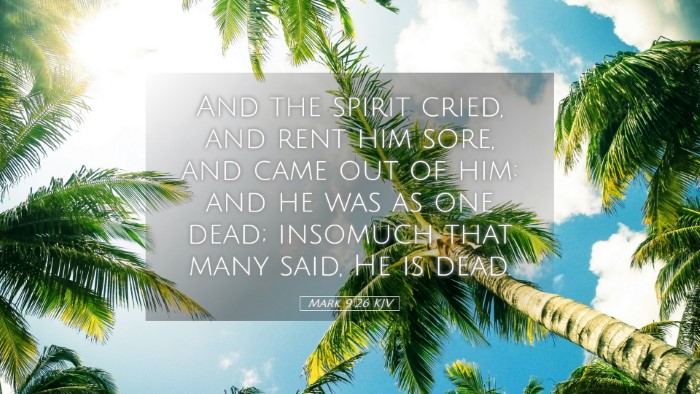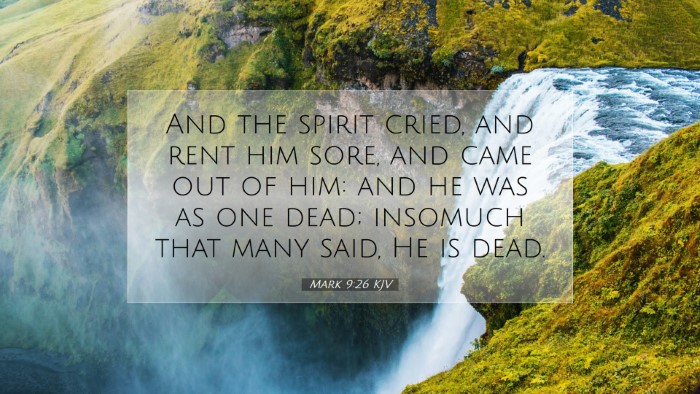Commentary on Mark 9:26
Verse Reference: Mark 9:26 - "And the spirit cried out, and convulsed him greatly, and came out of him; and he was as one dead, insomuch that many said, He is dead."
Introduction
This verse occurs within the context of Jesus healing a boy possessed by an unclean spirit. The intensity of the spirit's departure and the boy's condition lead to significant theological implications worthy of deeper contemplation.
Analysis of the Verse
In Mark 9:26, we witness the climax of a dramatic confrontation between Christ and demonic forces. Following the boy's convulsive actions and the spirit's violent screams, the narrative highlights the extent of suffering experienced by the child. The response of the onlookers—many judging the boy to be dead—offers a profound insight into the public perception of divine intervention, suffering, and restoration.
Commentary from Matthew Henry
Matthew Henry emphasizes the critical moment of conflict when the spirit cries out. He asserts that this illustrates the power and authority of Christ over evil spirits. Henry notes that the convulsions reflect the destructive nature of demonic possession. The boy's lifeless state post-exorcism serves to stress the finality and severity of the battle fought. Henry concludes that even when the situation appears hopeless, it is in such moments that Christ's power shines most clearly.
Key Insights from Henry
- Divine Authority: The casting out of the spirit shows Christ's sovereignty over the spiritual realm.
- Human Suffering: The intense suffering of the boy reflects the reality of sin and its consequences in the world.
- Public Skepticism: The reactions of the crowd reveal a common misunderstanding regarding the nature of miracles and divine healing.
Commentary from Albert Barnes
Albert Barnes provides a scholarly perspective, highlighting the significance of the spirit’s cries as a reflection of both anger and despair in its defeat. He remarks that the convulsions and the boy appearing as dead underscore the extremity of the situation. Barnes suggests this is a metaphor for spiritual death, underscoring how closely tied physical manifestations can be to spiritual realities. The crowd’s assertion that the boy is dead hints at the theatrical drama often seen in miraculous events, suggesting a need for deeper faith and understanding among witnesses.
Key Insights from Barnes
- Symbolism of Death: The boy's state serves as a symbol of spiritual death, emphasizing the need for spiritual rebirth.
- Cultural Relevance: The response of the crowd speaks to the prevailing beliefs about death and healing in ancient cultures.
- Importance of Faith: The miracle challenges witnesses to reconsider their perceptions of what is possible through faith in Christ.
Commentary from Adam Clarke
Adam Clarke delves into the linguistic and cultural elements of the text, shedding light on the original Greek terms used for the spirit's departure. He points out that the phrase "came out of him" implies a forceful removal, signifying a complete deliverance. Clarke also emphasizes the emotional weight of the moment—suggesting that the boy's post-exorcism condition evokes both pity and reflection on human vulnerability. Clarke's commentary nudges readers to confront the hopelessness of situations where divine intervention is requisite.
Key Insights from Clarke
- Exegesis of Language: The original Greek gives depth to the desperation of the exorcism process and its ultimate success.
- Human Vulnerability: The depiction of the boy’s condition invites an empathetic response from the audience.
- Call to Spiritual Reflection: The passage encourages readers to reflect on their dependency on divine grace in times of need.
Theological Implications
Mark 9:26 raises important theological questions about suffering, healing, and the nature of faith. The physical manifestations of the boy's distress serve as metaphors for the spiritual struggles present in all of humanity. This passage offers a lens to view the complexity of the human condition and the redemptive power of Christ.
Reflections for Pastoral Practice
For pastors, this passage serves as a potent reminder of the real struggles faced by congregants. It emphasizes the need for pastoral care that acknowledges both spiritual and emotional turmoil. The narrative challenges spiritual leaders to cultivate an environment of hope and divine expectation in their ministries.
Educational Insights for Students and Theologians
Students of theology and scholars can use this passage to explore the intersections of faith, spirituality, and psychology. Understanding the cultural context adds depth to theological training while helping shape a holistic view of healing in ministry.
Conclusion
Mark 9:26 encapsulates a profound moment that speaks volumes about the dynamics of suffering, the power of faith, and the overwhelming compassion of Jesus Christ. The insights derived from historic commentaries enrich our understanding and encourage deeper reflection on the intricacies of spiritual warfare, divine authority, and the hope found in Christ.


